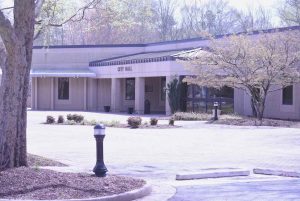Attention, Peachtree City constituencies for the tennis center, swimming under the “bubble,” tot lots and children’s playgrounds, ever-increasing lengths of cart paths, left-turns into business areas, and, yes, even sports fields. Changes are coming.
The city manager of Peachtree City, Jon Rorie, has conducted three workshops with the City Council so far this year, all centered around citizen expectations versus available money.
While his remarks were in front of council members and city staff, the intended audience for his repeated pithy sayings has been the general population of Peachtree City, all 35,000 or so of them.
Some of Rorie’s sayings: “Protect the cash.” “Long-term sustainability.” “We can’t spend it if we don’t have it.” “We can’t be all things to all people.” “We have to safeguard our community.” “When citizens ask, ‘Can’t you just (fill in the blank)…,’ sometimes the answer has to be no.” “We have to make decisions in the best interests of 35,000, not one.” “You can spend one dollar only once.” “Do we keep doing things the way we’ve always done them, or do we change?”
The clincher: “What does the future look like? The future is here. We’ve got choices to make.”
Here’s what he’s preaching to the council, and to the public: We can’t maintain all the stuff we have with the money we have coming in. So some things will have to be cut, or consolidated, or ownership shifted.
In the area of the city’s top priority, public safety, both the police department and the fire-EMS departments are having trouble hiring good people fast enough to cover the departure of experienced officers for better-paying jobs all around the metro area.
The likely response: starting pay for police, fire and EMS will get a $2,500 a year bump, just to keep competitive.
• The city-owned tennis center, now leased to a management company, is a money-losing proposition. The city’s costs to resurface tennis courts — still a city responsibility — are more than the city receives in rent for the center. And the center has fewer than 600 yearly dues-paying members. “The math doesn’t work,” Rorie said.
• The Kedron aquatic center, also known as the “bubble” for the seasonal covering of the swim area, is another sinkhole of city funding. It has only a small percentage of city residents using it regularly. However, changes there would impact the school system’s swim teams, which has no comparable Olympic-sized pool in which to practice. But changes are coming.
• Tot lots for small children are scattered in several neighborhoods, but most have been around for two decades and — with other playgrounds — need refurbishing. Likely outcome: closing some and consolidating others.
• “There are some cart paths that need to be removed,” Rorie said. He mentioned Battery Way, Cedarcroft and Center Green as stretches that need to be looked at. Maintaining remaining paths will be a high city priority.
• Left turn median cuts into Westpark Walk and other business areas are likely to go away, especially on Ga. highways 54 and 74. While affected businesses often complain that customers will have a harder time getting into shopping areas, Rorie said studies show that generally such changes don’t cause long-term retail damage.
• Sports fields, their costly upkeep and their even more costly upgrades, such as artificial turf replacing muddy grass fields, are being looked at closely. They have a large constituency, into the thousands, but users are likely going to pay more in the future.
Rorie recalled that it took the city a decade for its sales tax revenue to catch up after the Great Recession. He said maintaining a healthy nest egg is critical to protect the city government’s delivery of needed services from the next financial downtown.
As things stand now, Rorie said, city departments have made requests that put the next budget into the red by a million dollars. Since the city, by law, can’t operate with a deficit, as Rorie kept saying, “Decisions have to be made.”
Preliminary budget hearings are next into the summer months, and with the number of people likely to be affected by the upcoming city budget, the council’s audience participation is likely to increase. And if Rorie is right, many will be saying, “Can’t you just …?”
For an in-depth look at city discussions about city services and budget constraints, read the minutes of an earlier City Council workshop below:
minutes of an earlier City Council workshop below:
In depth — Peachtree City’s Council and staff talk on the record in city-transcribed minutes about managing and paying for city facilities and programs
The following are transcribed discussions by the City Council of Peachtree City, city staff and various citizens at the public meetings.
Topic: Managing and paying for city facilities and programs
From the April 2, 2019 council workshop minutes:
The Mayor and Council of Peachtree City met in Retreat workshop session on April 2, 2019. Mayor Vanessa Fleisch opened the workshop at 6:30 p.m. Council members attending: Terry Ernst, Mike King, Kevin Madden, and Phil Prebor. Workshop topics were facility management and departmental service capacities.
City Manager Jon Rorie reminded the group that this was the second of three planned Retreat workshops. The first, held on March 5, dealt with economic development and redevelopment. Community Improvement Districts (CIDs), traffic, and roads. The Retreat sessions were designed to break down “big picture” issues into smaller topics for discussion. This would ultimately lead to the decisions that must be made during the budget process. The topics for this workshop included examining what facilities management involved and the service capacities of three departments: Recreation, to include Buildings and Grounds, along with the Police and the Fire Departments. Those, plus Public Works, consumed most of the budget dollars.
Rorie again stated the City’s mission was to supply high-quality services to the City’s 35,000 residents, who each had their own opinions about what was needed. In March, they talked about safeguarding the community going forward. He said they should be trying to set the stage for the future. He repeated one of his favorite sayings — “ A little well done was better than a lot just done,” adding that they could not be all things to all people at all times. They must focus their attention on accomplishing the greatest good for the greatest amount of people.
Safeguarding the community involved constantly balancing the means, or revenues, with the ends, or expenses. They needed to figure out how to provide these services in the most cost-effective manner, keeping in mind that sometimes those needs could not be met. Rorie went on to note that he was often asked to provide a service that was politically acceptable, but not administratively sustainable. The only way to give services was for the City to take. Every time there was an incremental decision, it provoked a down chain event.
They should be examining the opportunities and the risks that might impact the City in the future. Planning for those situations would allow for choices. Rorie said they should look at the past and try to create the future by evaluating the opportunities and risks that they knew would be coming.
Rorie presented a “wordle” that he used at the March Retreat. It used the One PTC study to show things residents liked, such as the cart paths, safety, and community. It showed that sports programs were a little less popular than the path system, which ranked high. The aquatics center was cited less often. Fireworks were listed as popular. Rorie noted that the fireworks show itself cost $26,000, but that cost did not all include the cost of all the labor that went into the July 4 activities. That one day wound up costing around $60,000. Low crime rate was also cited. Rorie said that would be discussed later.
Suggested improvements mentioned the need for a central gathering place and the lack of affordable housing, maintenance of amenities was cited. Being over-policed was mentioned as a complaint, and that would fall under a discussion of service capacities. Well-paying jobs was also mentioned as a need. Rorie said he often heard people say they needed to recruit high-paying jobs.
In the March Retreat,it was noted that about 15,000 people drove out of the City to work every day, and about 16,000 commuted to Peachtree City. Rorie asked if developing a piece of property in the industrial park could lead to those high-paying jobs. The industries would have to be targeted to ensure that they would provide good jobs that would allow people to live and work in the City. The list of needs also included maintenance of the path system.
Rorie presented a list of what residents thought would be the biggest challenges over the next decade. Traffic was near the top, but Rorie said that was only an issue at a few intersections. Surrounding development, also high on the list, was related to traffic because as development surrounded the City, it would impact traffic. Jobs and path maintenance also were listed, as was the updating of recreation facilities. About 60% of the respondents named crime as a problem.
Rorie went over the City’s budget policy, which called for establishing a baseline budget that served as an agreed upon point of departure for subsequent budget discussions. Any additional services above that baseline should be fully funded at the time of the adoption of that budget and ongoing funding sources should be clearly identified. These funding sources must be new or clearly identified through expense reductions. He remarked that this was a nice way of saying that a dollar could only be spent once, and they should figure out what would give the best return on that dollar.
Rorie referred to the work of the Needs Assessment Committee of 2013. It asked respondents to rank five City departments in terms of their importance to them. Police was first, followed by Fire, then Public Works. Recreation was fourth, with the Library fifth. The gap was not great between any of these, however, Rorie pointed out, it depended on what the respondent thought was most important.
Another question asked about the amount of property taxes paid in relation to the services they received. Most agreed that they paid a fair amount of taxes for the services received. Most people also agreed that the City did not spend too much on any one service. These responses begged the question of where cuts could be made if that was what Council wanted. He recalled the outcry a few years ago when they cut the Library’s book budget by $25,000.
The City owned 41 buildings and 25 structures, such as the Pavilion at Drake Field and the City Hall plaza fountain. They budgeted $6,000 for annual maintenance of the fountain. That sounded like nothing until the $6,000 was multiplied by years and years. That was what was meant by facilities maintenance. The insured value of buildings and facilities was roughly $56 million, Rorie noted.
The 2019 budget allocated $511,000, or about 1.4% of the total budget, for building repair and maintenance. That line in the budget also dealt with items such as pest control contracts, heating and air conditioning service, backflow, fire alarms, and so on. Those were day-to-day expenses, but $175,000 went to other maintenance needs, such as bathroom upgrades and painting.
They had invested about $330,000 over the past few years in bridges and tunnels. This year, $100,000 was set aside for safeguarding them. Rorie showed a photo of a cart path bridge that went over a stream. Water ran underneath the pipe instead of through it. He asked if it was it better to spend the money to repair it or remove it entirely. He showed the location on a map and pointed out that there were other routes if the bridge was removed. He said he did not know the answer, but that was what facilities management was about.
A photo of playground equipment showed that even “maintenance-free” concrete required some maintenance. Signs were subject to wear and tear as well. A scorekeeper’s stand at the Peachtree City Athletic Center (PAC} needed painting. Other buildings there also needed work. A sinkhole at the tennis courts on Blue Smoke had needed repair. All Children’s Playground had been patched, and equipment had required replacement, which Rorie said had been done under warranty. Residential toilets were installed and had to be replaced with commercial ones.
Many of these problems were dealt with through a $3 million facilities bond. The 2015 bond called for replacing roofs at the Tennis Center. the Library, and the Police Department. Other items included renovations at the Amphitheater. The importance of any of these depended on an individual perspective. Rorie commented.
[Note: The above text came directly from the transcribed minutes of the April 2 City Council of Peachtree City workshop.]











Leave a Comment
You must be logged in to post a comment.